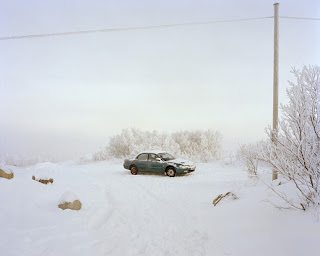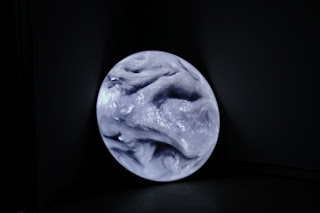In the room where Angelica Mesiti's Citizens Band is displayed at ACCA's NEW12 we find ourselves surrounded by four screens. One after the other, short films of people in public places performing an unexpected form of music are projected on the screens. As Juliana Engberg says in the catelogue essay, each film is a portrait of the person as they perform. It focuses primarily on their face, with a clarity that shows pores and creases, hair and sweat. The intimate nature of the close-ups contrasts with the setting of the performance. One is in a public swimming pool, another a train, the third on a street corner and the last in a taxi. These films celebrate the joy of an individual being able to express a profound part of themselves without the anticipation of applause. The music they play creates a bridge between a turbulent internal world of emotions and the structured outside world of language and order. These performers seem at times like transmitters who have something that passes through them.
In the first film an athletic Cameroonian woman (Geraldine Zongo) beats out a complex rhythm using the water in a bright blue swimming pool. There is an ecstatic energy in her performance that seems as much about endurance as skill. The close ups of water splashing up in her face seem at points like sweat from the exertion of beating the water. The film audience are transfixed by her skill, her concentration, her strength and the incongruity of playing the water in a swimming pool like African drums. By watching her, we understand something of an inner exuberance, of a blood beating heart pumping pressure that needs release. As she sinks into the water, after her performance, we appreciate her cool fulfilment.
In the second film an Algerian man (Mohammed Lamourie) plays a Cassio keyboard and sings on the Parisian Metro. The keyboard has sticky tape holding one of the keys together. The music he plays has similar sense of tension and release to Zongo's music. However, it comes from a much more melancholic place. His music sounds like the feeling of trying to control your breathing so you don’t start crying. As passengers board the train we see the range of reactions to this public release of emotions in a musical form. A blurry kissing couple seem to be laughing, a woman who wants to read a supermarket advertising brochure seems annoyed and keeps look up with disdain, young girls totally ignore him and share their music on their I pods. A man who must stand near him looks a little awkward at having to be in such close proximity. This is the only film in which we get to see the reaction of the public, in the pool Zongo seems alone and in the other two the outside world is only vaguely present. In the train we sense that Lamourie’s intense expression of something deeply personal is received by the outside world as crossing lines boundaries of suitable behaviour. It must be ignored in a space where people who do not know each other must sit so close together.
In the third film a Mongolian man (Bukhchuluun Ganburged) sits on a street corner playing a horse head fiddle and throat singing. This type of singing produces harmonic pitches of sound simultaneously over a guttural drone. One sound is like a deep growl, and another very high and pinning. On this street corner, outside a convenience store, people walk past this remarkable performance that growls out of this man. The ordered and itemised outside world of daily activity and exchange is in the hazy background of night. Cans of deodorant are lined up in the window behind him. We buy such things to feel greater control over our body and its internal machinations that tend to seep out without constant vigilance. Ironically, this man outside the shops is able to control the internal. He can manipulate the way his vocal folds open and close. However, the many sounds he creates evoke the very physical and uncontrollable sensation of grief—at once sharp, bright and stinging as well as the dark heavy ache.
In the fourth film a Sudanese taxi driver (Asim Goreshi) whistles a beautiful complex melody inside his car as traffic goes past. He seems less exposed then the others. The whistling brilliantly resinates with acoustic depth that is almost unimaginable from the inside of a car. It sounds more like a concert hall filled with the voice of an opera singer. Yet it is also very humble. Every so often we also hear the driver quietly bring his lips together and we are re-familiarised with the natural sound quality in a taxi. These little sounds emphasise the power and strength of the whistling by their difference. The car, even a public car such as this, can become this private space on a public road. Goreshi seems to communicate a longing or love in his whistle and takes the simple idea of ‘whistle while you work’ to an operatic intensity. Initially, the camera sutures us into this film—like we are observing from the perspective of a passenger. However, like the other films, there are shots that are extreme close ups that make us aware that we are being shown these people and their modes of musical expression in much more intense and intimate proximity then we would see in real life. Like the people in the train or walking past the convenience store, in real life we may fail to appreciate the beauty of these performances.
At the end of the fourth film, coloured lights like those of the cars that went past the taxi, circulate around the four screens. The audience is surrounded by the coloured lights whizzing past and the sound of all four performances being played at the same time. After the intimate portraits we have watched, the busy assemblage of sounds and lights gives the audience a perspective of the distance in which we usually perceive strangers in crowds, queues and cars that surround us. The music that the people made in their portraits is complex and structured like the language we must acquire to function and be understood in the outside world. It is language that enables us to develop relationships where we can bring our internal needs into a structure that can be made sensible. However, in each of these performances the musician is able to express something beyond the perimeters of language and metaphor. Their performances are unique moments in time that convey a rich and satisfying personal expression. Mesiti shows us the beauty and worth of these moments.
Anna Newbold


































